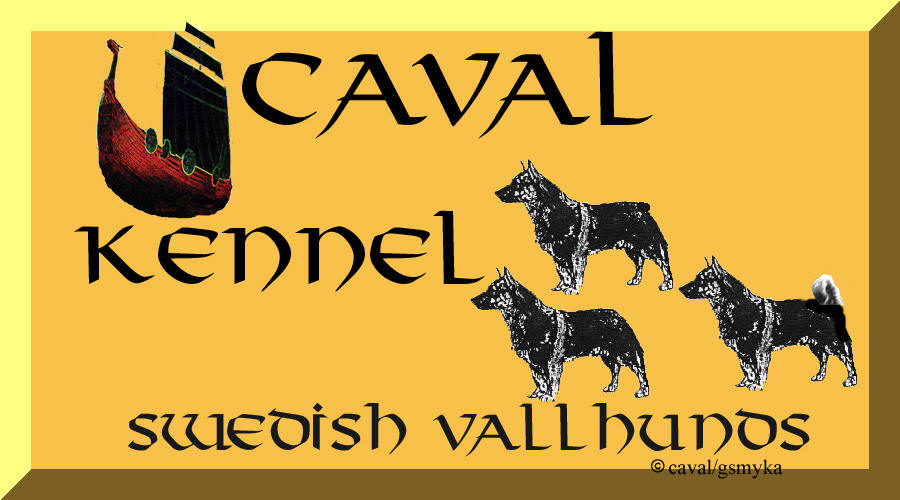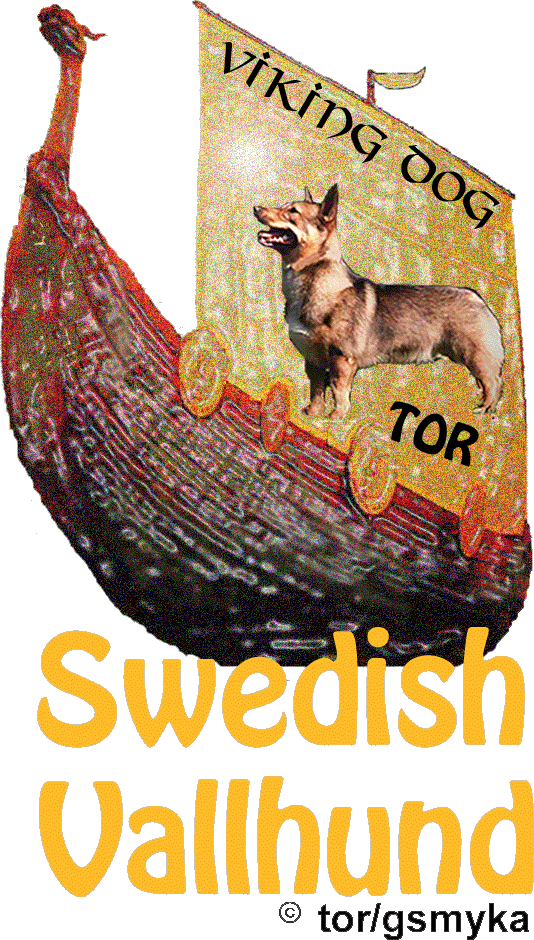|
SWEDISH VALLHUND CLUB OF AMERICA
STANDARD OF THE BREED
Ratified by the Membership, 10/18/2004
GENERAL APPEARANCE-The Swedish Vallhund (SV) is a very old
Spitz-type breed known since the time of the Vikings. For centuries the SV
has been kept as a farm dog and used for herding cattle. The SV is a
small, powerful, fearless, sturdily built Spitz herding dog. The correct
relationship of height to length of body is 2:3. The SV has a wedge-shaped
head, prick ears, and a close-fitting hard coat of medium length and sable
coloring. The double coat and the characteristic "harness markings" are
essential features of this breed. Tail may be natural (long, stub, or bob)
or docked. The appearance of the Swedish Vallhund conveys intelligence,
alertness and energy. Balance, outline, temperament and movement are of
overriding importance. The SV is a thoroughly sound animal, versatile in
its desire to do traditional herding or with proper training compete in
companion events such as obedience, tracking and agility, and/or serve as
a family companion.
SIZE, PROPORTION, SUBSTANCE—Height-- Height at the withers
for dogs ranges from 12.5 – 13.5
inches and bitches 11.5 – 12.5 inches. Minor
variations may be seen; however, more important is the proportion.
Proportion--The relationship of height to length of body, as measured
from the prosternum to the rearmost portion of the buttocks, should be
2:3. Substance-- Strong, well boned, well developed, neither
refined nor coarse, and a solidly built, muscular body.
HEAD-- Rather long and clean. Viewed from above, the head forms an
even wedge from skull to tip of nose and is well filled-in under the eyes.
Eyes-- Medium size, oval in shape and dark brown with black eye
rims. Ears-- Medium size, pointed, prick. Set at the outer
edge of the skull above a line drawn from the corner of the eye.
Ear leather should be firm from base to tip,
smooth-haired and mobile.
The dog should make good use of them. Skull-- Broad and almost
flat. Stop-- Well defined. Muzzle-- Viewed from the
side, the muzzle should look rather square, slightly shorter than the
skull. Planes-- The top lines of the muzzle and skull are parallel
to each other. Nose-- In profile, the nose is on the same
line as the muzzle and does not extend beyond the forepart of the muzzle.
Pigmentation-- Black. Lips-Black and tight with no
noticeable flews. Teeth-- Strong, well developed, with full
dentition
in a scissors bite. Any deviation is a serious fault.
NECK, TOPLINE & BODY-- Neck-- Long, strongly muscled with
good reach. Topline-- Level when standing or moving. Chest -- Good
depth. The ribcage is long with fairly well sprung ribs. Viewed from the
front, the chest should be oval; from the side, elliptical. In a mature
dog it should reach down two-fifths of the length of the forelegs and,
when viewed from the side, the lowest point of the chest is immediately
behind the back part of the foreleg. The prosternum is visible and not
excessively pronounced. Underline-- Slightly tucked up. Back--
Well muscled. Loin-- Short and strong. Croup-- Broad and
slightly sloping. Tails-- Tails may be long, stub, or bob. May be
shown natural or docked. All tail types are equally acceptable.
FOREQUARTERS--
Shoulders-- Strongly-muscled. Shoulder blades--
Long and well laid back. Upper arms-- Slightly shorter than the
shoulder blades, set at an approximate 90 degree angle, close fitting to
ribs, but still very mobile. A line perpendicular to the ground can be
drawn from the tip of the shoulder blade through the elbow to the ground.
Elbows-- Move parallel to the body, turning neither in nor out.
Forearms-- When viewed from the front, slightly curved to give free
action against the lower part of the chest; the pasterns and feet are
parallel. Viewed from the side the forearms are straight. The height from
ground to elbow is almost half the height from ground to withers. Legs
– Well boned. Pasterns-- Slightly sloping, elastic.
Dewclaws-- May be removed. Feet-- Medium sized, short, oval,
pointing straight forward. Toes-- Tightly knit and well knuckled.
Pads-- Thick and strong.
HINDQUARTERS – Angulation-- To balance the front.
Well angulated at stifle and hock. Legs--
Well boned. Upper and lower thighs are strongly muscled. Lower
thigh is slightly longer than the distance from hock to ground.
Stifles-- Well bent. Hocks (Metatarsal bones)-- Perpendicular
to the ground and viewed from the rear, parallel. Feet, toes and pads--
Same as forefeet.
COAT-- Medium length hair, harsh; topcoat close and tight. Undercoat
is soft and dense. Hair is short on the head and the foreparts of the legs
and slightly longer on neck, chest and back parts of the hind legs.
Dogs are to be shown in an untrimmed, natural state. Faults include wooly,
curly, or open coats. Fluffy coats (longer hair on body and furnishings,
with ear fringes) are a serious fault.
COLOR-- A sable pattern seen in colors of grey through red and
combinations of these colors in various shades. All are equally
acceptable. Lighter shades of these colors are desirable on the chest,
belly, buttocks, lower legs, feet and hocks, with darker hairs on back,
neck, and sides of the body. Lighter harness markings are essential.
Although a dark muzzle is acceptable, a well-defined mask with lighter
hair around eyes, on muzzle and under the throat, giving a distinct
contrast to the head color is highly desirable. White is permitted as a
narrow blaze, neck spot, slight necklace, and white markings on the legs,
and chest. Whitein excess of one third of the dog's total color is a very
serious fault. Any color other than described above is a very serious
fault.
GAIT-- Sound with strong reach and drive. The Swedish Vallhund is a
herding dog requiring agility and endurance. Viewed from the front, the
legs do not move in exact parallel planes, but incline slightly inward to
compensate for shortness of leg and width of chest. The forelegs should
reach forward in a free stride without too much lift. Hind legs should
drive well under the body and move on a line with the forelegs, with hocks
turning neither in nor out. Feet should travel parallel to the line of
motion with no tendency to swing out, cross over or interfere with each
other. Short, choppy movement and overly close or wide movement is faulty.
TEMPERAMENT-- The breed is watchful, energetic, fearless, alert,
intelligent, friendly, eager to please, active, and steady, making a good
herding and companion dog. Sound temperament, neither vicious or shy.
Any departure from the foregoing points should be considered a fault,
and the seriousness of the fault should be in exact proportion to its
degree.
The following faults are to be so severely penalized as to effectively
eliminate the dog from competition: Fluffy coat, any color other that
described above, nose not predominantly black, more than one-third white,
any bite other than scissors.
|

